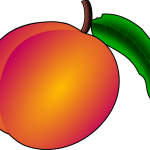EARLY ORANGE
 Characteristics: an early ripening apricot variety from the USA, which is suitable for both fresh eating and preserves. It is one of the most popular apricot varieties among Polish consumers. The tree is resistant to frost, it starts to bear fruit early and it yields heavily and regularly.
Characteristics: an early ripening apricot variety from the USA, which is suitable for both fresh eating and preserves. It is one of the most popular apricot varieties among Polish consumers. The tree is resistant to frost, it starts to bear fruit early and it yields heavily and regularly.
Fruit: medium-sized (weight: 30-45 grams), round-oval, regular. The skin is shiny, intensively orange covered by a bright red, washed blush. The flesh is dark orange, firm, sweet, aromatic, juicy, very tasty. The stone falls away easily from the flesh.
Ripens/Harvest: late July
Pollinators: Morden Apricot, Harcot;
GOLDRICH
 Characteristics: an early ripening dessert apricot variety from the USA with incredibly attractive fruit. The tree is very resistant to low temperatures. The tree starts to bear fruit early and it yields heavily and regularly.
Characteristics: an early ripening dessert apricot variety from the USA with incredibly attractive fruit. The tree is very resistant to low temperatures. The tree starts to bear fruit early and it yields heavily and regularly.
Fruit: medium-sized to large (weight: 60-80 grams), oval, flattened at the sides. The skin is yellow or light orange, covered by a small red blush with small spots. The flesh is orange, firm, a little acidic, aromatic, not too juicy, very tasty. The stone falls away easily from the flesh.
Ripens/Harvest: late July
Pollinators: Early Orange, Morden Apricot;
MORDEN APRICOT
 Characteristics: an early ripening apricot variety from Canada, it is especially attractive due to its high resistance to frost and spring ground frost as well as low susceptibility to diseases. The tree starts to bear fruit early and it yields heavily and regularly.
Characteristics: an early ripening apricot variety from Canada, it is especially attractive due to its high resistance to frost and spring ground frost as well as low susceptibility to diseases. The tree starts to bear fruit early and it yields heavily and regularly.
Fruit: medium-sized to large (weight: 30-50 grams), oval, regular. The skin is quite strongly fuzzed, light orange with a blush. The flesh is orange, firm, sweet, slightly aromatic, juicy, very tasty. The stone falls away easily from the flesh.
Ripens/Harvest: late July
Pollinators: considered to be self-fertile, however, it is more productive in the presence of Harcot or Early Orange;
HARCOT
 Characteristics: a very appreciated early ripening apricot variety from Canada. It is a dessert variety, which is excellent for eating fresh due to its sweet fruit as well as for all kinds of pastries, desserts or preserves. The tree is quite resistant to frost. The tree starts to bear fruit early and it yields heavily and regularly.
Characteristics: a very appreciated early ripening apricot variety from Canada. It is a dessert variety, which is excellent for eating fresh due to its sweet fruit as well as for all kinds of pastries, desserts or preserves. The tree is quite resistant to frost. The tree starts to bear fruit early and it yields heavily and regularly.
Fruit: medium-sized to large (weight: 40-60 grams), round-oval. The skin is smooth, intensively orange, covered by a bright red, washed blush. The flesh is dark orange, firm, sweet, aromatic, juicy, very tasty. The stone falls away easily from the flesh.
Ripens/Harvest: late July
Pollinators: Early Orange, Morden Apricot;
SOMO
 Characteristics: a late ripening apricot variety from Poland. It is a dessert variety, which is excellent for eating fresh and for all kinds of pastries, desserts or preserves. The tree is very resistant to low temperatures. The tree starts to bear fruit early and it yields heavily and regularly.
Characteristics: a late ripening apricot variety from Poland. It is a dessert variety, which is excellent for eating fresh and for all kinds of pastries, desserts or preserves. The tree is very resistant to low temperatures. The tree starts to bear fruit early and it yields heavily and regularly.
Fruit: small to medium-sized (weight: 20-35 grams), round-oval. The skin is smooth, intensively orange, covered by a dark red blush. The flesh is yellowish-orange, firm, sweet, aromatic, juicy, very tasty. The stone falls away easily from the flesh.
Ripens/Harvest: mid August
Pollinators: self-fertile;
HARGRAND
 Characteristics: a late ripening apricot variety from Canada resistant to frost. Like all apricots it’s rich in antioxidants which have numerous health benefits (they prevent heart diseases, cancer, have anti-ageing qualities, they help to control blood cholesterol levels, etc.) and is a good source of vitamin A (from beta-carotene) and vitamin C. The tree is very resistant to low temperatures. The tree starts to bear fruit early and it yields heavily and regularly.
Characteristics: a late ripening apricot variety from Canada resistant to frost. Like all apricots it’s rich in antioxidants which have numerous health benefits (they prevent heart diseases, cancer, have anti-ageing qualities, they help to control blood cholesterol levels, etc.) and is a good source of vitamin A (from beta-carotene) and vitamin C. The tree is very resistant to low temperatures. The tree starts to bear fruit early and it yields heavily and regularly.
Fruit: large to extra large (weight: 70-80 grams; at times they can reach up to 1 kg), round-oval, slightly flattened at the stem. The skin is orange, covered by a small, spotted, dark red blush. The flesh is orange, very firm, sweet, slightly aromatic, juicy, very tasty. The stone falls away easily from the flesh.
Ripens/Harvest: mid August
Pollinators: Goldrich, Harcot;




